SciArt profile: Elad Bassat
Posted by the Node, on 10 January 2024
In this SciArt profile, we get to know more about Elad Bassat, the scientist behind the artwork ‘Klimt-olotl’, which was chosen as both the Judges’ choice and People’s choice in the ‘Science-inspired art’ category of the Node-BSDB virtual art exhibition.
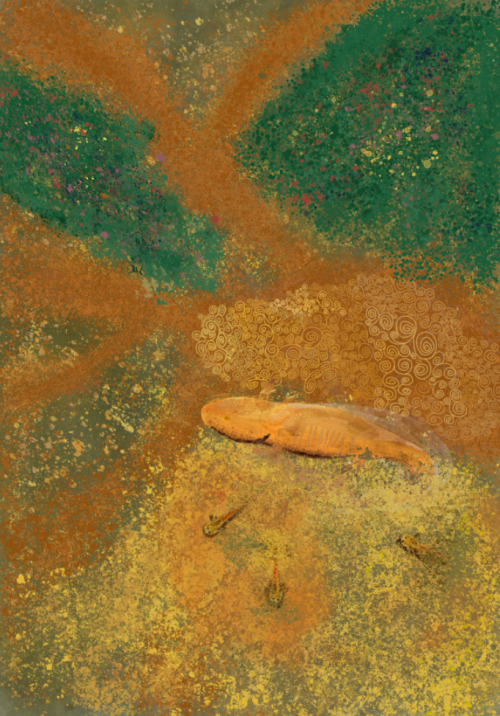
Can you tell us about your background and what you work on now?
I have been a regeneration enthusiast for the majority of my scientific career. Ever since I started my masters (and later my doctoral) work in the lab of Prof. Eldad Tzahor in the Weizmann Institute of Science, I was always fascinated how some animals can achieve amazing feats of regeneration while we cannot. I continued my regeneration journey moving to Vienna and becoming a post doctoral fellow in the lab of Elly Tanaka (a position I still hold today), essentially moving from working with mice to working with the cutest model organism in existence, the axolotl. Specifically, I am working on two different projects: what is the role of the extracellular matrix in axolotl limb regeneration and how does the axolotl regenerate its heart. I hope that in the near future I will be able to wrap up my projects and look for an independent investigator position in which I could combine my previous mouse experience with the axolotl work and study regeneration across species.
Were you always going to be a scientist?
In short, oh yeah!
In my high school, the Hebrew Gymnasium of Jerusalem, at the 9th grade, the students are tasked with choosing their major subjects. This entails sitting and listening to, sometime boring and dry, descriptions of what will be taught by the teachers and as you can imagine, I also found it boring and tedious. However, one of the teachers, which taught Biology, told us: “Instead of telling you what I will teach you, I will show you what this could be useful for…” and then she told us about treating diseases and improving yields of crops and genetic engineering and… I was hooked.
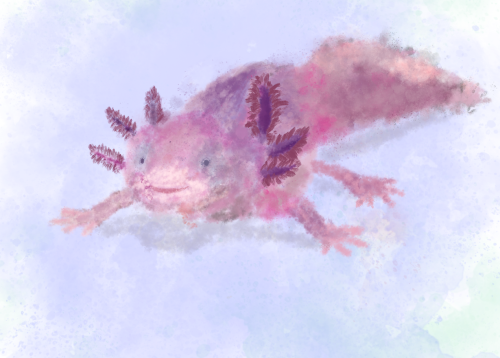
And what about art – have you always enjoyed it?
I want to put an asterisk here – *compared to the amazing artists who participated in the competition, I consider myself a non-artist. I always enjoyed seeing art, but I was and still am very bad at this. My mother is very skilled in painting, jewelry making and other arts and crafts, so I dabbled in painting as a kid, but I was always inpatient and unhappy with myself when the straight line I wanted to draw turned out curved. So, for many years after this, I didn’t attempt to paint or do anything “artsy” again. During my university days, I started to play with digital art, mostly experimenting with photoshop and illustrator and then I identified the one thing I was missing when I was painting as child, an “undo” button. From this point on I started to generate models and illustrations for colleagues and for the labs I was working in. To this day, the majority of the art I generate is aimed to make my presentations more fun or to communicate my science better.
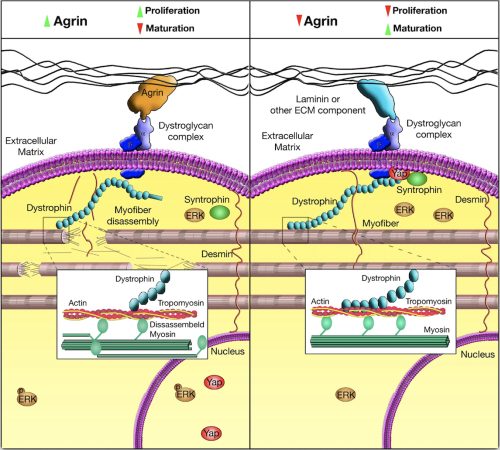
What or who are your most important artistic influences?
Honestly, I don’t think I have “most important” artistic influences, I appreciate specific pieces of art in museums and exhibitions, and I admire those who created them. For example, I visited museums in Vienna and saw beautiful works of the Austrian artist, Gustav Klimt. Following this, I went home and tried to copy his style and that is how “klimt-olotl” was born, combining my science model with the art I admired. Similarly, I visited the Albertina museum in Vienna and saw Pointillism paintings by Seurat and Signac which apart from being inspiration for amazing R-packages for bioinformatics, are artists I truly admire. I was so impressed with “the pink cloud” by Signac that I tried to draw with a similar style immediately when I got home only to fail miserably (although I am still practicing this technique).
I think I should also include one additional avenue of inspiration and that is the works of many Sci-Artists on twitter which I follow (such as @DrawImpacts, @maayanvisuals and @Ella_Maru). I often find the beautiful illustrations, models, and graphics they generate, truly inspiring.
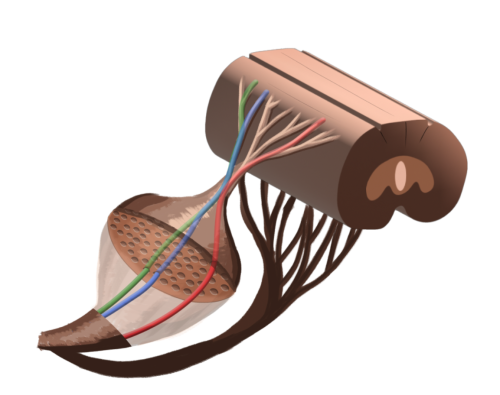
Your painting ‘Klimt-olotl’ was both the People’s and the Judges’ choice in the BSDB-the Nodevirtual art exhibition. Can you tell us more about the story behind the artwork?
As I mentioned before, I currently live in Vienna and I enjoy visiting the many art museums we have in the city. As Gustav Klimt was an Austrian artist there are many locations in the city you could see his works and stylistic influence. About two years ago there was an interactive exhibition titled the “Klimt: the immersive experience” which we decided to go with my 3-year-old son, and he loved it. After questioning him a bit more he mentioned that he loved, what I would paraphrase, his color palette especially from the golden period. After that we went home and we started drawing together and he asked me to outline spirals and shapes that he would later color with the Klimt palette. After he went to bed, I took my tablet and started playing with the actual color palette and shapes used in “The Kiss”, “The Woman in Gold”, and “Death and Life” and noticed I am seeing a separation of water and land. From this point a few days have passed and my mind was focused on my scientific work and I thought about how axolotls have the same type of separation between water and land as they would normally would not metamorphose in nature, so it just clicked that they should be also represented in the image.
How do you make your art?
Apart from painting with my son (which is currently limited to painting unicorns), I only paint electronically using my tablet and computer. I would generate the image using the Apple pencil and then perform special functions, post-processing and add effects using photoshop and illustrator.
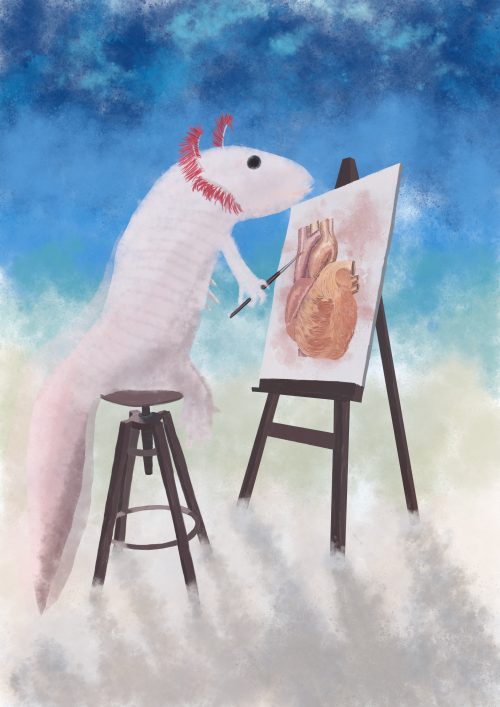
Does your art influence your science at all, or are they separate worlds?
I don’t think anything is really separated in my head. I can’t think of a specific example where seeing an art exhibition influenced me to run a specific experiment but when I see or make art my mind wonders and then new ideas are generated. In the end I think we are the sum of all our experiences, they are intermingled, and they shape the next decisions you make.
What are you thinking of working on next?
Honestly I don’t know, I haven’t drawn anything in the last few months and my motivation is down given what is happening in my home country. Since the 7th of October attack on Israel I find it hard to think about what’s next.
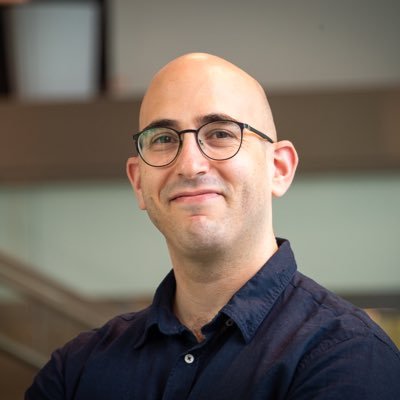
Follow Elad on Twitter/X:


 (No Ratings Yet)
(No Ratings Yet)